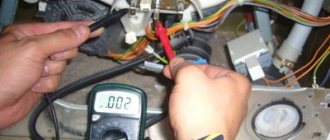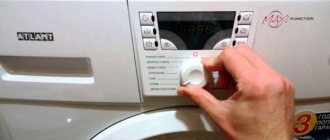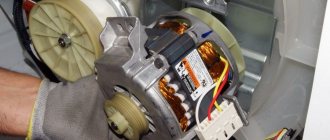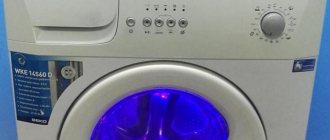Technological progress has greatly simplified everyday life and now almost every apartment and every house has a washing machine. If you have chosen an LG brand car, then we can be happy for you, because understanding the modes and controls of all models of this brand is very simple and accessible to everyone.
All the nuances of use are described in the instructions, but it happens that it is difficult for the average person to understand or is missing, for example, when buying used equipment. This article briefly describes the main programs, modes, functions and answers frequently asked questions about how to wash in an LG washing machine.
What factors determine the washing time in a washing machine?
Let's look at this issue using a practical example (if your washing machine has a digital time display, then you can easily experiment without turning on the machine).
So, let’s turn on the “Cotton” mode - it is available on most models (further the indicators will be given for the “VEKO” washing machine; for others they will not be much different).
What do we see?
- total time: 1h.57m;
- temperature: 60°C;
- spin: 1000 rpm.
Let's set the temperature to 90 oC. We see that the process time has increased to 2h.26m. At t=40 oC the time will decrease to 1h.37m, at t=30oC – to 1h.32m.
Let's change the spin parameters. What do we see? When changing the number of revolutions, the total time does not change; it decreases only if the spin is turned off altogether.
Let's turn on the additional "Soak" function. The total time increased from 1.57 to 2.14.
Thus, using the example of one mode, we saw that its duration strongly depends on the heating temperature of the water, increases with the inclusion of the additional “Soaking” function and is absolutely independent of the number of revolutions during the spin cycle.
Of course, in machines from other manufacturers, the spin time may increase with increasing speed, but 2-5 minutes will not save anyone. In addition, it should be mentioned that the duration of the wash does not depend on the load on the drum; in some new models, the weight of the loaded laundry affects the consumption of water and detergent.
In the “Cotton” mode, it is recommended to wash cotton, linen and similar fabrics, or, more simply, fabrics that can be washed in very hot water and wring out well. When turning on the “Soak” function, do not forget to pour the powder into the appropriate powder section (read the instructions for your washing machine).
Let's look at other basic washing modes that are available on almost all machines.
“Cotton Eco” or similar – lasts about 3 hours depending on the model
As the manufacturers say, in this mode the machine washes very carefully and carefully, with preliminary soaking in warm water and thorough rinsing.. The “baby underwear” mode has approximately the same characteristics - after all, children’s clothes should be washed carefully and carefully, every mother knows this
The “children’s underwear” mode has approximately the same characteristics - after all, children’s clothes should be washed carefully and carefully, every mother knows this.
By the way, these modes include a pre-washing or soaking function, and for this you need to specifically pour the powder into the appropriate section of the powder tray, as mentioned above. If you don’t do this, then for the first half hour your things will simply be rinsed in warm water.
Let's look at other most common operating modes of modern widespread washing machines:
- Synthetic fabrics - lasts 1.5-2 hours, temperature limit is 40°C, and you cannot add the temperature manually, as in the “Cotton” mode;
- Wool or silk - duration about 50 minutes, spin limit - 600 rpm;
- Hand wash – lasts about an hour, heating limit – up to 30°C, spin – 600 rpm.
There are some other modes depending on the model and brand, for example, “Mix”, “Shoes”, “Curtains”, “Jeans” - each manufacturer tries to make their product the best and most attractive, endowing it with “irreplaceable” functions.
Selecting a washing program
Before choosing a washing program, you need to pay attention to the composition of the jacket filler. Down and feathers (“down”, “feather”) are natural ingredients. They have a fatty layer and can become matted if not properly cared for.
To wash natural down jackets, it is recommended to use modes with the following parameters:
- temperature – 20-30°C;
- spin speed is no more than 400-500.
In LG machines, these criteria are met by the “Delicate Fabrics”, “Hand Wash”, “Silk” and similar programs.
Instead of studying the programs in the instructions for the unit, you can independently set the necessary parameters. Hollow fiber, synthetic winterizer, polyester and other synthetic fillers (“polyester”, “fiber tech”, “hollow fiber”) are more resistant to deformation. However, at high spin intensity they clump and decrease in volume.
For washing down jackets with such insulation, the following parameters are recommended:
- temperature – up to 40°C;
- spin speed - no more than 600 (some manufacturers recommend up to 800).
In addition to programs for delicate fabrics and silk, you can use the “Wool” and “Synthetics” modes for cleaning. In the second case, the owner will have to adjust the spin intensity.
To care for jackets with wool or batting filling (“wool”, “cotton”), the “Wool” program is suitable . If the care instructions indicate that the item can only be washed in cold water or at a temperature not exceeding 30°C, then it is necessary to adjust the mode parameters before starting washing.
Duration of washing modes
What makes up the time of one washing cycle is more or less clear, let’s now consider the most common programs and modes, and see what their duration may be. In this case, we will talk about a specific mode and its built-in parameters, which can be changed manually, namely temperature, spin speed, this, as we have already noted, also affects the washing time. Most washing machines have the following modes:
For some of these modes, you can set additional functions, such as super rinse, pre-wash, which means that you need to add another 15 to 30 minutes to the time indicated above.
Does washing time depend on the type and model of washing machine?
The answer to this question is obvious; of course, the washing time depends on the model of the automatic washing machine. In modern models, the manufacturer tries to reduce energy consumption as much as possible, reducing the duration of washing modes, thereby making the machine economical. But on average, this time still differs by 20-30 minutes. You can find more accurate washing times for a specific mode in the instructions for the washing machine, and if you do not have a printed version of the instructions, you can find them on the Internet.
As for the type of loading of the washing machine, it does not affect the duration of the wash. and with front loading have similar modes, the duration of which may differ, but not significantly. Both have a quick wash mode and an intensive wash mode.
For those who care about the duration of the wash, it is best to choose those models of washing machines whose display shows the remaining wash time. In addition, the delayed washing function will be convenient, which assumes that the machine will start on its own after a period of time from 3 to 19 hours.
So, washing time in an automatic machine can range from 15 minutes to 4 hours. Everything will depend on the combination of parameters and factors that we listed above. Do your laundry correctly and with pleasure!
One of the first to introduce direct drive technology. The concept of attractive design and functionality has been successfully brought to life. Therefore, many users prefer equipment from this brand. In addition to the efficient operation of internal components, electronic control offers various washing modes in the LG washing machine. Our article will help you figure out which one to choose.
LG washing machine control panel
Most LG models are produced in Russia, which is why the control panels are completely in Russian and are very simple. There are practically no icons or symbols next to the rotary selector, buttons and on the display; everything is signed with words.
How to choose a washing program and wash in an LG machine: step-by-step instructions
- Sort items by color, dirtiness, and according to the instructions on the labels.
- Place items in the drum, observing the recommended weight of laundry for one wash.
- Place the required amount of powder in the special compartments and add conditioner.
- Connect the washing machine to the electrical network.
- Press the button to turn on the machine.
- Rotate the selector to set the mode.
- If necessary, set additional spin, rinse and water temperature parameters.
- Press the start button to start washing. All stages, temperature and remaining time will be shown on the display or indicated by flashing indicators next to the corresponding buttons.
- When the wash is completed and the items are removed, it is recommended to wipe the inside surface with a dry cloth or leave the door ajar to dry the parts and prevent excess moisture from accumulating.
- Remember to turn off the machine from the electrical outlet to avoid accidental starting.
Running programs
The symbols on the control panel look more stylish, the icons take up less space, but users are often confused and cannot decide which mode the symbol corresponds to. To decrypt, you constantly need instructions for the machine. Moreover, the drawings are not standardized, and each manufacturer creates them at their own discretion. This is why it is so difficult to switch from a machine of one brand to a model of another brand.
As for Beko washing machines, their control panel is full of inscriptions. Perhaps because of this, the machine does not look so stylish and impressive, but the user does not get confused in the programs. However, you will have to find out the description of the modes, namely such parameters as: washing time, water heating temperature, spin speed. Before starting the “cycle”, you should understand the purpose of special programs.
Let's present a description of the special. programs found on Beko machines.
- Cotton. Designed for washing cotton linen, the water heating temperature varies from 60 to 90 degrees. Ideal for cleaning heavily soiled durable fabrics. Spinning of things occurs at maximum speed. The cycle duration is approximately 2-2.5 hours.
- Eco-cotton. A program designed for washing cotton fabrics with minimal electrical energy consumption. The duration of the cycle is about three hours.
- Dark fabrics. This mode is ideal for synthetic and cotton items in matching shades. The water is heated to a maximum of 40°C, thereby preventing the products from shedding. Washing time – 1 hour 40 minutes.
- Synthetics. The program starts when washing synthetic clothes and combined fabrics. The moderate heating temperature of the liquid prevents shedding and deformation. Cycle duration is 105-120 minutes.
- Shirts. The water is heated to a maximum of 40°C, spinning is performed at low speed. The program prevents the formation of wrinkles on shirts. Washing takes approximately 2 hours.
- Mix 40. General mode in which there is no need to separate laundry into batches according to fabric type. Can be used for washing both synthetics and cotton. The cycle duration is adjustable.
- Express. Suitable for lightly soiled items. The water warms up to 40°C, the spin speed can be adjusted. Washing takes about one and a half hours.
- Pooh. Special program for cleaning blankets and outerwear with appropriate filling. Can be used to “scroll” regular products. Washing time – 60 minutes.
- Sport. Used for cleaning sports uniforms. Suitable for removing hard-to-wash stains and coping with the unpleasant odor of sweat. Cycle duration is from 100 to 140 minutes.
- Mini. The mode starts when a small batch of lightly soiled laundry is loaded into the machine. The operating time of the washing machine is from 30 to 90 minutes, depending on the water heating temperature set by the user.
- Handwash. Program for gentle care of delicate fabrics. Prevents item deformation and wear. The cycle lasts approximately 40-55 minutes.
- Wool. The mode is designed specifically for cleaning woolen products. The “dumping” of the material is eliminated due to the slow rotation of the drum. Washing time is about 70 minutes.
- Kids' things. Involves thorough rinsing of laundry. Washing takes place in hot water, cycle duration is 2 hours 40 minutes.
- Self-cleaning. The mode required for the washing machine to be “washed” from the inside. It starts "idle". The program execution time is 2 hours.
- Jeans. Ideal for denim items, eliminates shedding of products. The duration of the mode is 100-105 minutes.
- Refreshing wash. For lightly soiled clothes. Fights unpleasant odors. The machine runs for only 17 minutes.
- Economy mode. Wash in cool water (20°C), suitable for slightly dirty laundry. It is advisable to replace the powder with a readily soluble liquid product. Cycle duration is 100 minutes.
The duration of the cycles is approximate, in fact the time may “shift” on different Beko models. The exact washing duration, as well as the water heating temperature and spin speed when choosing a specific program, should be found in the instructions for the washing machine.
Basic modes
Different models of machines have different lists of modes and functions, but some modes are found in almost all machines. They can be selected both in machines from the Bosch and Zanussi brands, as well as in models from Samsung, LG and other manufacturers. These include:
- Washing cotton.
This mode can be called the most common, since you will see it in almost any automatic machine. This mode is used to wash heavily soiled cotton items and bed linen. Typically, such washing involves heating the water to +950C, however, there are programs for washing cotton with a lower temperature. The spin cycle in this program is set to the maximum number of revolutions that your machine model allows. - Washing synthetics.
This program is also very common and is used for clothes made of synthetic fabrics, as well as for washing mixed laundry. Water heating for this program is usually carried out to +600C. Washing in this mode is quite long, and the available maximum speed is used for spinning. - Hand wash.
This common mode is chosen for washing clothes made from thin fabrics that require careful care. Tulle is often washed using this program. Typically, water for hand washing is heated to +300 or +400. The rotation of the drum in this mode is slow and gentle, but there is no spin. - Delicate wash.
Like the previous mode, this washing is indicated for thin fabrics that need careful handling, however, the main difference will be the presence in the spin program with a low number of revolutions. - Washing wool.
This program is typical for most devices and is intended for items made of wool. This mode provides gentle washing with low water heating and no spin. - Daily laundry.
This program is designed for relatively quick (its average duration is from 40 to 60 minutes) cleansing of clothes that are not too dirty. During such a wash, the water heats up to +300 or +400, and it is recommended not to completely load the machine with laundry. - Quick wash.
A program with a short washing cycle is present in almost all machines and can be called differently, for example “Super quick wash”, “Quick 15”, “Quick 29”, “Express 15” and so on. This mode is chosen for lightly soiled clothes that need to be washed quickly. The duration of such a program is up to 30 minutes, the water is heated to +300 or +400, and the spin speed is set to maximum. - Intensive wash.
The main purpose of this mode is to wash very soiled clothes. Since water is usually heated in such a program to high temperatures (+60+900C), such washing is not recommended for delicate fabrics. The duration of this program is from 90 to 120 minutes. - Pre-wash.
This mode consists of two consecutive washes, so you should pour two portions of detergent into different compartments into the powder dispenser. The program is used for very dirty laundry with stains that have become ingrained and cannot be washed out under normal conditions.
Icon definitions are in the operating instructions
What factors determine washing time?
Any model of washing machine performs the task in several stages:
- The main stage of washing.
- Rinsing things.
- Spinning clothes.
The duration of a certain cycle depends on several factors. For example, the higher the temperature set by the manufacturer or user, the longer the washing cycle will be. If fast mode is selected at a temperature of 30 0 C, then the duration will be short.
The extra rinse option also increases the wash duration. On average, this add-on adds 20 to 40 minutes to the task completion time. The machine will need more time to perform a high-quality spin. For example, if the machine spins things at 800 rpm per minute, then it takes an average of 12 minutes to complete this stage. If the spin is selected at 1000 per minute, it will take 15 minutes.
The following options also increase the time it takes to complete a task with a Bosch washing unit:
- The extra wash option adds 15 to 30 minutes.
- Likewise, the soaking process increases the time.
- Heating water to 95 0 C.
- Boiling things.
- In many innovative washing units from LG and Bosch, the washing duration increases depending on the weight of the items loaded into the tank.
- The dirtier the items, the longer the washing process.
Insidious Mode Duvet
Most modern LG models have a special Duvet mode, which is designed for washing bedspreads, textiles and blankets with various fillings.
Regardless of the insulation material, this program is not suitable .
If you study the mode parameters, you will notice that the washing temperature is 40°C, and the spin intensity is 1000 rpm. Cleaning under such parameters will lead to deformation of the filler and a sharp deterioration in its heat-insulating properties.
How to iron and dry clothes after washing
Wäschetrockner, BaWa 004
It is worth noting that gentle washing alone is not enough to preserve the original appearance of products. It is recommended to dry and iron clothes properly.
Tips for drying delicate materials:
- if you did not use a spinner, hang things on hangers over the bathtub and let the water drain;
- Never dry wet items on a line in a bent state or attach them with clothespins;
- either hang the product on hangers or lay it out on a horizontal, preferably mesh, surface;
- to speed up the process, do not place clothes on a radiator or other sources of artificial heat;
- Do not leave light-colored laundry to dry in the sun; try to hang the items in the shade;
- Place the guipure and lace on a flat horizontal surface and cover with absorbent material.
Tips for ironing delicate fabrics:
- for processing, use a high-quality iron with a clean and smooth sole;
- first, try ironing an inconspicuous area of the material with a slightly warm iron, see if the treated area is deformed;
- iron wool at a maximum of 180 degrees only through slightly damp cotton fabric;
- Either do not iron synthetics at all, or set the iron temperature to 110 to 130 degrees, and process only through cotton fabric;
- Iron the organza through a thick sheet of paper at a temperature of 100 to 110 degrees;
- iron silk clothes from the inside out slightly damp, setting the iron temperature to a maximum of 160 degrees; if the material is dry, to prevent streaks from appearing, do not spray the fabric, but moisten it by wrapping it in a damp towel;
- It is better not to iron velvet items, but to treat them with steam from a steam generator or by hanging the item over a bathtub with hot water;
- products made of nylon and elastane cannot be ironed;
If you are unsure of the type and origin of the material, look at the label on the product. The crossed out iron icon means that ironing clothes is prohibited, and the number of dots in the center indicates the degree of heating of the device.
How to reduce washing time?
Let's look at this issue using a practical example (if your washing machine has a digital time display, then you can easily experiment without turning on the machine).
What do we see?
- total time: 1h.57m;
- temperature: 60°C;
- spin: 1000 rpm.
Let's set the temperature to 90 oC. We see that the process time has increased to 2h.26m. At t=40 oC the time will decrease to 1h.37m, at t=30oC – to 1h.32m.
Let's turn on the additional "Soak" function. The total time increased from 1.57 to 2.14.
Thus, using the example of one mode, we saw that its duration strongly depends on the heating temperature of the water, increases with the inclusion of the additional “Soaking” function and is absolutely independent of the number of revolutions during the spin cycle.
Of course, in machines from other manufacturers, the spin time may increase with increasing speed, but 2-5 minutes will not save anyone. In addition, it should be mentioned that the duration of the wash does not depend on the load on the drum; in some new models, the weight of the loaded laundry affects the consumption of water and detergent.
In the “Cotton” mode, it is recommended to wash cotton, linen and similar fabrics, or, more simply, fabrics that can be washed in very hot water and wring out well. When turning on the “Soak” function, do not forget to pour the powder into the appropriate powder section (read the instructions for your washing machine).
The “children’s underwear” mode has approximately the same characteristics - after all, children’s clothes should be washed carefully and carefully, every mother knows this.
By the way, these modes include a pre-washing or soaking function, and for this you need to specifically pour the powder into the appropriate section of the powder tray, as mentioned above. If you don’t do this, then for the first half hour your things will simply be rinsed in warm water.
Let's look at other most common operating modes of modern widespread washing machines:
- Synthetic fabrics – lasts 1.5-2 hours, temperature limit is 40°C, and you cannot add the temperature manually, as in the “Cotton” mode;
- Wool or silk – duration about 50 minutes, spin limit – 600 rpm;
- Hand wash – lasts about an hour, heating limit – up to 30°C, spin – 600 rpm.
- As mentioned above, washing time significantly depends on the heating temperature of the water, so set the maximum temperature only in exceptional cases. For cotton, linen and similar fabrics, 60°C is quite enough.
- For the “quick” washing mode, do not set the temperature above 40°C, since heating the water is absolutely pointless - the program is too short, and you will spend extra time and money on electricity.
- If you know at what temperature a particular item should be washed, at what speed it should be wrung out, and whether pre-soaking is necessary, then you can easily adjust the necessary washing parameters on the same “Cotton” mode, and the time will be optimal. After all, most modes are just variations to lure the buyer.
- Try using a delayed start - it is not necessary to let the machine wash when you are at home. The main thing is to be there when the laundry is washed so that it can be hung to dry. For example, you can set a timer in the evening so that you can take out the laundry when you wake up. Or vice versa, set the timer in the morning so that the machine finishes washing when you come home from work.
- One of the cases of increasing washing time can be called “overwashing”. In order not to waste time on re-washing, you need to choose the right operating mode - it’s better to wait an extra 20 minutes than to then re-wash for an hour and a half with the appropriate state of mind. As already mentioned, very often after the express mode, powder stains remain on things, so it’s better to immediately rinse again - you’ll save time and your nerves.
And a couple more tips. Before putting bulky and poorly wetted items into the drum of the washing machine, for example, a bologna jacket, down jacket, pillow, I would advise you to pre-wet them, especially if the washing machine is small. The fact is that such things, when dry, occupy the entire cavity of the drum, do not get wet, and the ribs of the drum do not mix them.
To ensure that your laundry is always perfectly clean, use high-quality detergents - powders, gels, conditioners. Bad powder means not only unwashed items, but also the appearance of new stains that are removed by repeated rinsing. It is better to use liquid gel - pour it directly into the drum along with the laundry you are loading.
How to wring and dry?
Wringing the jacket by hand can cause deformation of the filling and outer fabric, so it is recommended to use a machine spin at minimum speed .
To prevent wrinkles and improve the quality of spin, you need to put 2-3 dry towels in the drum.
Dry the down jacket only in a vertical position, on a hanger, in a room with good ventilation. To avoid clumping, shake it occasionally or lightly tap it with a carpet beater.
It is forbidden to dry a down jacket over steam, near heating radiators or in the open sun. If the instructions allow automatic drying, you can remove the moisture using a washing machine.
Secondary functions
In addition to the main and additional washing modes, in Ariston washing machines you can only select auxiliary functions, for example, only drain or rinse.
- Additional rinse. When this option is activated, the washing machine will perform one more rinse during operation. This is necessary to completely remove the detergent from the fabrics. This possibility is relevant for small children, people with sensitive skin or allergies, and also simply in cases where the detergent was added in more quantity than necessary.
- Individual mode. Allows you to store your own program in the washing machine’s memory, selecting all the necessary parameters for it.
- Spin only. As a rule, the user can independently select the speed when activating this option. This function may be relevant if, after completing a program, the laundry turns out to be very damp or for hand-washed clothes. This option can also be activated after a night wash has been completed, during which the Ariston machine operates very quietly, excluding all spin stages, both main and intermediate.
- Drain. This function can be used in the event of an emergency need to drain water from the tank, as well as in the event of a breakdown of the Ariston machine, when the equipment refuses to drain the liquid from the tank.
A detailed analysis of the operating modes of the LG automatic washing machine
The LG washing machine is a piece of equipment with high functionality.
Its main task comes down to high-quality processing of things. To do this, the manufacturer has built into it many modes, each of which is designed for a specific type of fabric. Their wise choice will allow you to achieve an impeccable result.
Read the article about what modes exist on an LG washing machine and how to use them.
Delicate laundry detergents
To gently wash clothes, washing machine manufacturers recommend using special detergents. These can be various gels for washing delicate types of fabrics, as well as other liquid products. Moreover, such products should not contain enzymes, phosphates and chlorine. Such products are well rinsed from fabrics, leaving the structure and color of the fabric in its original form.
Conventional powders spoil the color of products, and bleaches worsen their quality. For delicate washing you need special products without dyes and preservatives. The smell of such products is natural; they have a special marking indicating the type of fabric for gentle washing.
You can take products that contain lanolin; it has a mild effect on textiles while preserving the color of things. On the shelves of household chemical stores today you can also see special products that differ in purpose based on the type of fabric. Woolen and silk items cannot be washed with regular powder. For them you need to buy a liquid product for natural fabrics.
Gels are considered the best choice. They penetrate deeper into the fabric structure, are easier to wash out of it, and contain additives to maintain shape and soften water. Gels are suitable for removing various types of stains. They are safe and do not cause allergic reactions. You need to buy biodegradable products from the store. Among the many varieties of these products, one can note products from Nordland, Sion, Laska, and Cashmere.
Features of choice for different things
What mode should I use to wash tulle, jackets, jeans, bed linen? To prevent things from being damaged during the washing process, you need to select the right mode:
Tulle is processed in the Delicate wash mode.- Jeans are washed on the Mixed fabrics program.
- Bed linen is processed by turning on the Cotton option.
- Jackets are washed on the Duvet program.
- Diapers and rompers are cleaned in the Baby Clothes mode.
- For blouses, the Delicate wash option is suitable.
- Shirts and pajamas are washed on the Cotton or Cotton Eco program.
This article will tell you which mode to wash a down jacket in an LG washing machine.










